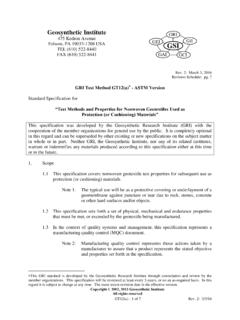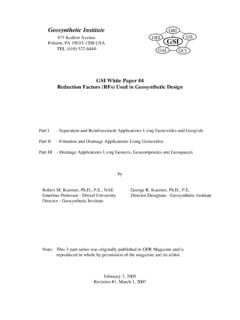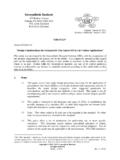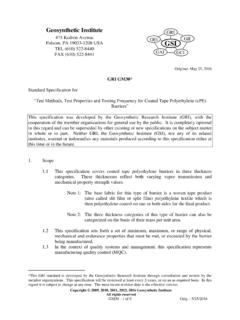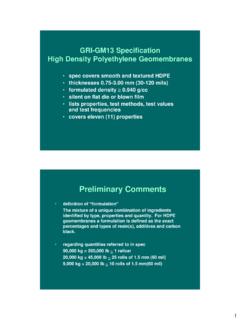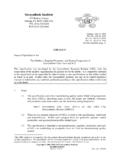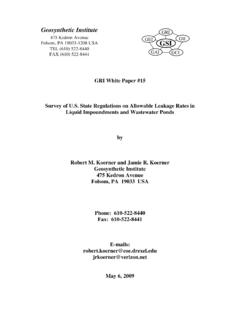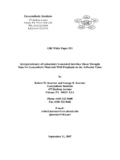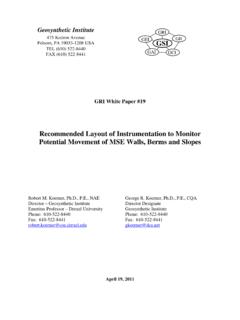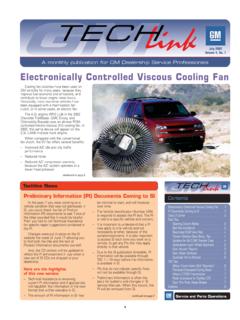Transcription of Intimate Contact Issue of Field Placed …
1 GSI White Paper #27 The Intimate Contact Issue of Field Placed Geomembranes with respect to Wave (or Wrinkle) Management by Robert M. Koerner, , , NAE George R. Koerner, , , CQA Director Emeritus Geosynthetic Institute Director Geosynthetic Institute Professor Emeritus Drexel University 610-522-8440 610-522-8440 (GSI Members, please note that there is also a fifty-five slide power point presentation accompanying this white paper. If interested, please advise.) June 6, 2013 Geosynthetic Institute 475 Kedron Avenue Folsom, PA 19033-1208 USA TEL (610) 522-8440 FAX (610) 522-8441 GSI GRI GII GAI GEI EI GCI The Intimate Contact Issue of Field Placed Geomembranes with respect to Wave (or Winkle) Management Abstract GSI either directly or through its on-line servicing of the techline receives many questions as to deployment of geomembranes and, more specifically (to the topic of this white paper), the fate of waves (or wrinkles) in geomembranes when they are backfilled and entombed by the overlying soil materials.
2 We generally respond by scanning various published papers but now feel it is time to summarize the relevant information in the form of a GSI White Paper (#27) which is posted on our website and available to everyone at After a brief overview and background of the situation, we describe a major laboratory study which was the dissertation of Dr. Te-Yang Soong and is very revealing in this regard. The major findings of that study being (i) that waves as small as 14 mm in height do not flatten out upon the application of normal pressure, (ii) that the waves actually collapse forming relatively sharp folds, and (iii) that residual stresses at the folds can be as high as 22% of yield where they are most accentuated.
3 As a result of a national survey of state regulatory agencies, the implications of entombed waves are then addressed followed by five methods for achieving Intimate Contact of the installed and backfilled geomembranes to their subgrade. A summary and recommendation section is also presented. -1- Overview and Background It is clear that the concept of a composite liner, , a geomembrane Placed over compacted clay liner (GM/CCL) or geosynthetic clay liner (GM/GCL), in the minds of regulators (and designer s as well) is to achieve a flat geomembrane completely over the substrate whatever it may be. That said, it is intuitive that waves or wrinkles will compromise this situation as the photographs of Figure 1 attest.
4 The generally voiced concerns over burying or entombing these waves are the following: Leakage flow through geomembrane holes into the open space beneath the wave Possible shortened life due to tensile stress concentrations in the folded geomembranes Mini-dam impediment to leachate flow along the upper surface of the geomembrane Distortion of the underlying CCL or GCL due to uneven stresses created by the wave Fig. 1 Waves in exposed geomembranes (GSI photos). The above said, it is well known that the waves are caused by elevated temperatures (in comparison to the geomembrane temperatures at placement and seaming) and are fundamentally related to the type of geomembrane resin as well as its stiffness and thickness.
5 Table 1 presents coefficients of thermal expansion/contraction for common geosynthetic resins. The table is followed by a numeric example illustrating the amount of expansion movement caused by a -2- temperature increase of 30 C which is a typical Field situation. The calculation is performed for HDPE, LLDPE and PVC geomembranes. Table 1 Coefficients of Thermal Expansion/Contraction (various references) Polymer Type Thermal Linear Expansivity ( 10-5 / C) Polyethylene high density medium density low density very low density Polypropylene Polyvinyl chloride unplasticized 35% plasticizer Polyamide nylon 6 nylon 66 Polystyrene Polyester 11-13 14-16 10-12 15-25 5-9 5-10 7-25 7-9 7-9 3-7 5-9 Example: What is the expansion of a 5 m long sheet of geomembrane due to a 30 C increase in temperature.
6 Use the table for HDPE, LLDPE and PVC values. Basic Equation: L = ( T)(L)( ) where L = expansion or contraction (+ or -) T = change in temperature (+ or -) L = distance between waves = coefficient of thermal expansion/contraction Solutions: Ex. T L L (expansion) (deg. C) (m) (/ C) (m) (mm) HDPE LLDPE PVC 30 30 30 15 10-5 11 10-5 16 10-5 22 16 24 Note: Due to stiffness effects, the HDPE and LLDPE geomembranes result in a single large wave, while the PVC geomembrane results in numerous small waves. -3- Figure 2a shows such waves (beneath a overlying white protection geotextile) being backfilled by the gravel of a landfill s leachate collection layer. These waves are indeed entombed by the backfilled materials and (as will be seen) retain their distorted shape even after exhuming as the photographs of Figure 2b indicate.
7 (a) Waves being entombed during backfilling (b) Entombed waves remaining after excavation Fig. 2 Various Field cases of poor wave management practice (GSI photos). It should be mentioned that waves in geomembranes on side slopes generally accumulate downslope due to day-to-night thermal cycling such that a final large wave often occurs at the Two Small Waves Being Entombed One Large Wave Being Entombed Many Removed Waves Several Field Removed Waves in mm (60 mil) HDPE -4- toe of the slope. Furthermore, such waves are often filled with water making the repair through multiple geosynthetic layers extremely difficult. A Major Laboratory Wave Study The concern over the fate of entombed and backfilled waves prompted a laboratory study sponsored by the Environmental Protection Agency which formed the dissertation topic of Dr.
8 Te-Yang Soong*. The study was conducted in both a large wooden box ( m) and in small steel boxes ( m). The large wooden box shown in Figure 3 had a m wide plexiglass window behind which the geomembrane waves were positioned. An air bag capable of 20 kPa pressure was used for normal pressure to observe the actual distortion of the as- Placed wave in the geomembrane over time. It is important to note that the ends of the geomembrane were short of the box width on both sides by 150 mm. Thus the geomembrane wave was free to move horizontally as pressure was applied at the surface if it was inclined to do so. Fig. 3 Large wooden box wave test setup. *Soong, and Koerner, R.
9 M. (1998), Laboratory Study of High Density Polyethylene Waves, Proc. 6th IGS Conf., Atlanta, IFAI Publ., pp. 301-306. *Soong, and Koerner, R. M. (1999), Behavior of Waves in High Density Polyethylene, Jour. Geotextiles and Geomembranes, Vol. 17, No. 2, pp. 80-104. -5- The results of three waves (large, medium and small) are shown in Figure 4. Fig. 4 Visual observations of large, medium and small waves under increasing pressure. Individual markers were Placed on the edges of the waves adjacent to the plexiglass window so that the same points could be observed in their movements (notice the small circles on Figure 4 sketches). In all cases, the as- Placed wave decreased in its void space under the applied pressure with the top moving down and the two sides collapsing inward.
10 In terms of a wave height-to-width ratio, the following occurred; large wave, H/W ratio went from to , medium wave, H/W ratio went from to , and small wave, H/W ratio went from to Most importantly the collapse of the waves did not shift the horizontal ends of the geomembranes toward the wooden box walls at all, , the geomembrane ends remained fixed Comment: Waves don t go away and the H/W-value increases -6- in their original position. This observation completely contradicts the often-heard notion that applied pressure tends to flatten the entombed waves. This simply does not occur since the increasing applied normal pressure also increases the friction on the top and bottom horizontal ends of the geomembrane holding them fixed in position even for these smooth HDPE sheets.
